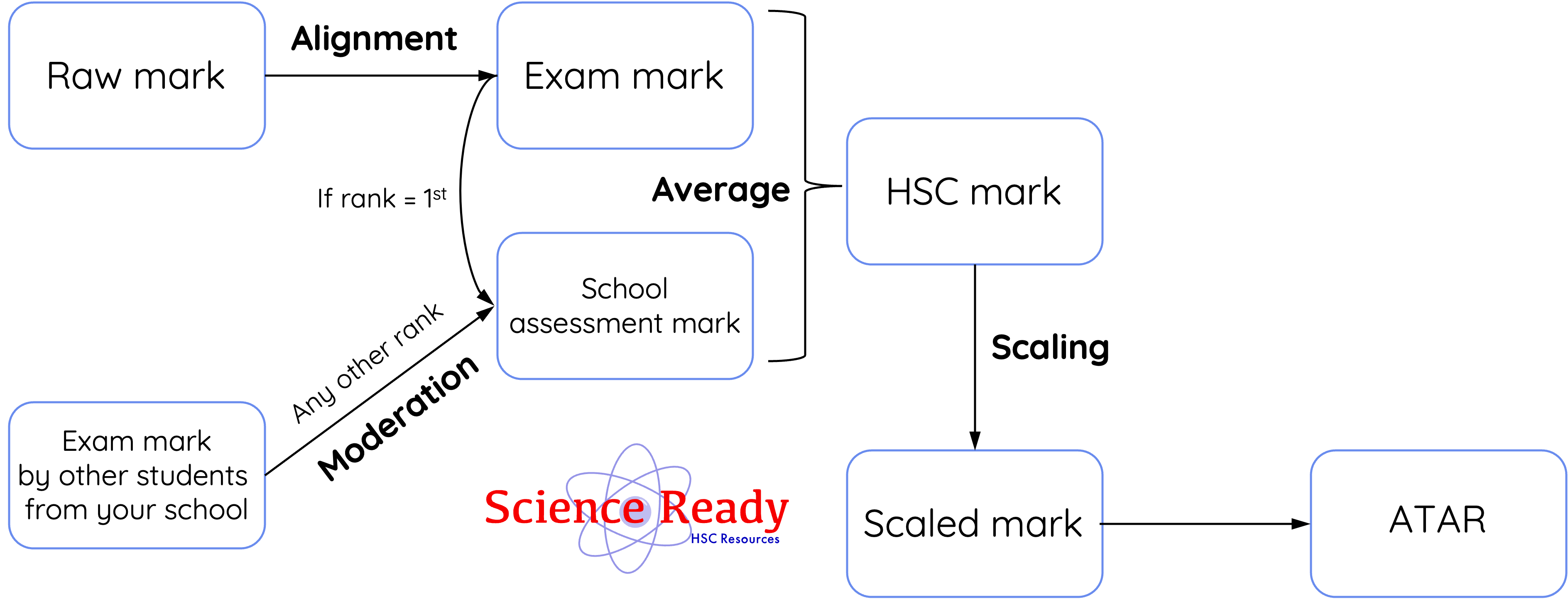Moderation, Alignment & Scaling Explained – HSC Chemistry & Physics
The conversion of your performance in school assessments and the HSC exam to your final ATAR is a complex process.
Your raw school assessment marks and HSC exam mark will be converted the a final scaled mark. The scaled mark is then used to calculate your ATAR.
What is a Raw Mark?
The HSC raw mark is the number of marks awarded to correct answers in the HSC exam. For chemistry and physics, the raw mark is out of 100 and is unmodified. The raw mark can only be known after purchasing the examination report from NESA.
What is an Exam Mark?
The HSC exam mark is the exam mark received by students on the HSC results day.
This number has been modified from the raw mark via a complex algorithm (known as alignment) to account for the variable nature of exam difficulty across different years. More difficult exams have more favourable alignment processes.
What raw mark is needed for a Band 6 in chemistry and physics?
A ‘Band 6’ refers to a HSC mark of 90 or more in chemistry or physics. The HSC mark is the average mark between your school assessment mark and exam mark.
Both HSC Chemistry and HSC Physics have favourable alignment compared to other subjects. In simpler words, the HSC exam marks for chemistry and physics are higher than raw marks.
The table shows the raw marks that correspond to Band 6 (90) and mid-band 6 (95) for chemistry and physics from 2019 to 2023.
|
Chemistry |
Physics |
|||
|
Aligned mark |
Band 6 (90) |
Mid-band 6 (95) |
Band 6 (90) |
Mid-band 6 (95) |
|
2023 |
85 | 94 | 82 | 91 |
|
2022 |
85 |
92 |
89 |
95 |
|
2021 |
84 |
92 |
82 |
90 |
|
2020 |
79 |
93 |
79 |
88 |
|
2019 |
81 |
90 |
76 |
87 |
Except for 2022, more correct answers are required to score a 90 and 95 in HSC Chemistry than in HSC Physics.
What is a School Assessment (Internal) Mark? What is Moderation?
The school assessment mark is determined by your internal rank for the subject, and the exam marks scored by students from your school.
For example, if your internal rank is first for chemistry, then your school assessment mark will be the highest exam mark scored by students from your school.
If your internal mark is 10th for chemistry, then your school assessment mark will be the 10th highest exam mark scored by students from your school.
This means, unless you are ranked first in the subject and have scored the highest exam mark, your school assessment mark will be affected by the exam performance of other students at your school. This process where either your or your peer's exam mark determines your school assessment mark is known as moderation.

This chemistry student scored an exam mark of 85 (after alignment) and an assessment mark of 85 (after moderation). The HSC mark is an average of the exam mark and assessment mark.
What is a HSC Mark?
The HSC mark is an average between your school assessment mark (internal mark) and exam mark. The HSC mark indicates the standard achieved by you in that subject.
An aligned mark over 90 means a Band 6 performance in the subject. This means, in order to achieve a Band 6 result, you must attain an average score of over 90 between your school assessment mark and the exam mark.
It is important to note that for each aligned HSC mark, there can be a range of raw marks. Two students who achieved the same HSC mark may have actually scored different raw marks in their exam.
What is a Scaled Mark?
The HSC scaled mark is produced when the aligned HSC mark is further modified to calculate a student’s total aggregate (out of 500). The scaled mark indicates the relative position of the student in the course if all students from the HSC cohort had studied the subject.
The aggregate from a student’s best 10 units of subjects is then used to calculate a student’s ATAR. The top 0.05% aggregate of the state will receive the top ATAR of 99.95.
Different subjects have different scaling algorithms. More difficult subjects like chemistry and physics tend to have more favourable scaling than other science subjects.
Chemistry and Physics Scaling
Chemistry and physics have more favourable scaling compared to some of the other commonly studied subjects.
|
HSC mark
|
Scaled mark
|
|
|
Chemistry
|
90
|
87*
|
|
Physics
|
90
|
86*
|
|
Biology
|
90
|
84
|
|
Mathematics Advanced
|
90
|
78
|
|
Modern History
|
90
|
79
|
|
Visual Arts
|
90
|
77
|
*Average of 2019-2022 statistics published by NESA. Scaled marks are rounded to integers.
HSC Mark vs Scaled Mark
It is important to distinguish between the HSC mark and the scaled mark because they serve different purposes. The HSC mark serves to indicate the standard within a subject achieved by the student whereas the scaled mark serves to indicate the relative ability of a student compared to others in the entire cohort (if they all had studied the subject e.g. chemistry or physics).
